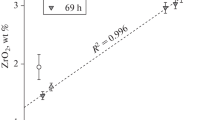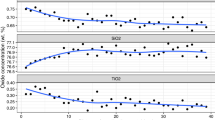Abstract
The simultaneous saturation of silicate melts with variable Al2O3 and SiO2 contents in sodium, potassium, and rubidium was investigated at a total pressure of 1 atm and temperatures of 1300–1470°C using the crucible supported loop technique. It was shown that an increase in both SiO2 and Al2O3 contents in the melt results in a significant decrease in the activity coefficients of the alkalis, and the effect of Al2O3 is especially pronounced in silicic compositions. The extrapolation of the experimental data allowed us to estimate the influence of SiO2 and Al2O3 contents in the melt on the behavior of Li and Cs. Using a numerical experiment, it was shown how the inert and perfectly mobile behavior of alkalis in magmatic processes can be discriminated. A methodic investigation was performed on the loss of Na, K, and Rb from silicic glasses during microprobe analysis depending on beam diameter.
Similar content being viewed by others
References
A. Acosta-Vigil, D. London, T. A. Dewers, and G. B. Morgan VI, “Dissolution of Corundum and Andalusite in H2O-Saturated Haplogranitic Melts at 800°C and 200 MPa: Constraints on Diffusivities and the Generation of Peraluminous Melts,” J. Petrol 43, 1885–1908 (2002).
A. Acosta-Vigil, D. London, T. A. Dewers, and G. B. Morgan VI, “Dissolution of Quartz, Albite, and Orthoclase in H2O-Saturated Haplogranitic Melt at 800°C and 200 MPa: Diffusive Transport Properties of Granitic Melts at Crustal Anatectic Conditions,” J. Petrol. 47, 231–254 (2006).
D. R. Baker, “Chemical Interdiffusion of Dacite and Rhyolite: Anhydrous Measurements at 1 atm and 10 kbar, Application of Transition State Theory, and Diffusion in Zoned Magma Chambers,” Contrib. Mineral. Petrol. 104, 407–423 (1990).
D. R. Baker, “Interdiffusion of Hydrous Dacitic and Rhyolitic Melts and the Efficacy of Rhyolite Contamination of Dacitic Enclaves,” Contrib. Mineral. Petrol. 106, 462–473 (1991).
A. Borisov, Y. Lahaye, and H. Palme, “The Effect of Sodium on the Solubilities of Metals in Silicate Melts,” Am. Mineral. 91, 762–771 (2006).
A. A. Borisov, “Experimental Investigation of K and Na Partitioning between Miscible Liquids,” Petrologiya 16(6), 593–605 (2008) [Petrology 16, 552–564 (2008)].
G. B. Morgan VI, A. Acosta-Vigil, and D. London, “Diffusive Equilibration between Hydrous Metaluminous-Peraluminous Haplogranite Liquid Couples at 200 MPa (H2O) and Alkali Transport in Granitic Liquids,” Contrib. Mineral. Petrol. 155, 257–269 (2008).
G. B. Morgan VI and D. London, “Effect of Current Density on the electron Microprobe Analysis of Alkali Aluminosilicate Glasses,” Am. Mineral. 90, 1131–1138 (2005).
C. H. Nielsen and H. Sigurdsson, “Quantitative Methods for Electron Microprobe Analysis of Sodium in Natural and Synthetic Glasses,” Am. Mineral. 66, 547–552 (1981).
H. St. C. O’Neill, “A method for Controlling Alkali-Metal Oxide Activities in One-Atmosphere Experiments and its Application to Measuring the Relative Activity Coefficients of NaO0.5 in Silicate Melts,” Am. Mineral. 90, 497–501 (2005).
R. D. Shannon, “Revised Effective Ionic Radii and Systematic Studies of Interatomic Distances in Halides and Chalcogenides,” Acta Crystallograph. A32, 751–767 (1976).
A. G. Simakin, T. P. Salova, Ya. Kuchereninenko, and V. A. Zharikov, “Influence of Cation Size in the Sequence Na-K-Rb on the Structure of Quartz-Feldspar Melts,” Petrologiya 12(6), 667–672 (2004) [Petrology 12, 589–597 (2004)].
E. B. Watson, “Basalt Contamination by Continental Crust: Some Experiments and Models,” Contrib. Mineral. Petrol. 80, 73–87 (1982).
Author information
Authors and Affiliations
Corresponding author
Additional information
Original Russian Text © A.A. Borisov, 2009, published in Petrologiya, 2009, Vol. 17, No. 6, pp. 623–635.
Rights and permissions
About this article
Cite this article
Borisov, A.A. Influence of SiO2 and Al2O3 on the activity coefficients of alkalis in melts: An experimental study. Petrology 17, 579–590 (2009). https://doi.org/10.1134/S0869591109060058
Received:
Accepted:
Published:
Issue Date:
DOI: https://doi.org/10.1134/S0869591109060058




